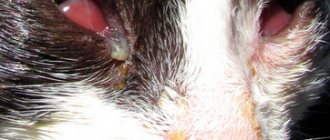Discharge from cat ears: common causes
When your cat's ears are healthy, they are pink and clean inside, odorless, have very little or no wax, and seem to be able to detect the sound of their can opener from a mile away.
When your feline friend has ear problems, you may notice a very different cat.
Symptoms of ear problems in cats include pawed ears, sensitivity to touch, large amounts of cream, orange, dark brown or black wax; hearing loss; tilting or shaking the head; and loss of balance.
The most common causes of ear discharge in cats include:
Ear diseases in cats
We have already said that ear diseases can have different etiologies. Let's look at the most common pathologies.
Ear mites (otodectosis)
Ear mites are a microscopic reddish-brown parasite that causes great discomfort to the animal. It is localized in the inner ear, where the ideal environment for the parasite to reproduce is warm and moist.
Symptoms
- twitching ears;
- strong shaking of the head;
- the presence of red-brown accumulations in the auricle (similar to ground coffee crumbs);
- unpleasant odor from the ears;
- copious sulfur discharge;
- hearing loss;
- sleep disturbance, restlessness;
- scratches, scratches, microtraumas of the auricle.
Causes
Cats become infected through contact from sick relatives. But not everyone gets sick, but only those animals with reduced immunity. Droopy ears, fur in the auricle and failure to comply with hygiene rules contribute to the development of pathology.
Treatment
The treatment regimen includes:
- ear cleaning;
- antiseptic and antihistamines;
- insecticidal drops (against ear mites);
Important!
It is necessary for a veterinarian to examine the animal, make a diagnosis and prescribe treatment - self-medication can lead to complete hearing loss.
Otitis
This is an inflammatory process in the inner, middle or outer ear. It is often a complication of otodectosis (ear mites). May lead to serious complications:
Symptoms
The symptoms are similar to those of ear mites (redness, increased wax production, itching). In addition, there may be an increase in body temperature and purulent discharge from the ears. However, with otitis media, the cat scratches its ears and shakes its head much less often and less than in the presence of ear parasites.
Causes
- parasitic otitis – a complication after otodectosis;
- bacterial (purulent) – secondary infection due to injuries, hypothermia and fungal infections.
Treatment
Only a qualified veterinarian should accurately diagnose and treat otitis media, as this is a very serious disease that can lead to serious consequences. Take your pet to the doctor and strictly follow all the doctor's instructions.
The treatment regimen includes:
- novocaine blockade;
- disinfection of the affected area;
- anti-inflammatory drops and ointments;
- antibiotics.
Wounds and injuries of the auricle
The outer part of the ear (pinna) is a protruding part that is often injured during cat fights, dog attacks, and falls from heights.
Symptoms
Traumatic lesions are visible to the naked eye.
- the ear is bleeding;
- the integrity of the skin is compromised;
- fur is torn off;
- full-thickness rupture of the auricle;
- suppuration;
- swelling;
- abscesses;
- redness.
Causes
- bites;
- bruises;
- scratches from claws.
Treatment
The treatment regimen is prescribed by a veterinarian. If the integrity of the ear is compromised, surgery may be required. In other cases, treatment comes down to treating the ears with antiseptics, antimicrobial, anti-inflammatory and healing agents.
Hematoma (bruise)
This is a type of blood blister that forms between the layers of the ear as a result of a cat scratching its ears.
Symptoms
- swelling;
- bleeding;
- soreness;
Causes
The main cause is a rupture of a blood vessel under the skin. Most often it occurs due to injury to the ear due to a bruise or strong scratching of the ear by a pet.
Treatment
Blood from damaged vessels collects into clots, which are surgically removed by a veterinarian. Conservative treatment with special ointments is also possible, which, after being prescribed by a doctor, are applied for several weeks.
Eczema of the ear
It is often a complication of inflammation of the outer ear.
Symptoms
- soreness;
- severe itching;
- swelling;
- skin redness;
- liquid dark discharge from the ears with an unpleasant odor;
- The cat often holds its head to the side and scratches its ears.
Causes
The cause of the disease can be foreign bodies, water or chemicals.
Treatment
You can help by removing the foreign body, using a syringe and a 3% solution of hydrogen peroxide to carefully rinse the accumulated exudate. Constantly wet areas should be lubricated with astringents prescribed by the doctor. For severe itching, corticosteroid ointments are prescribed.
Foreign body
This ear pathology is less common in cats than in dogs. Cats that go outside are at risk.
Symptoms
- the animal scratches its ear;
- shakes his head.
Causes
A blade of grass, moss, plant seeds or insects can get into the ear.
Treatment
Carefully inspect the outer part of the animal's ear in good lighting; if you see a foreign object, carefully pull it out with your fingers or using tweezers.
Important!
If the foreign body is deep, do not take risks, take the animal to the doctor, where it will be removed without consequences using anesthesia.
Polyps
Benign growths (growths) in the middle ear or eustachian tube. The danger of the pathology is that the eardrum may rupture.
Symptoms
- nasal discharge;
- loud and labored breathing.
Causes
The root cause of polyps in the ears has not been established. Young animals are at risk.
Treatment
Polyps are removed surgically in a veterinary clinic.
Tumors
Ear malignancies are rare in cats. Complications – deafness, death.
Symptoms
- hearing impairment;
- ulcerations;
- deformation of the ears;
- putrid odor;
- bleeding
Causes
Older cats are at risk. The root cause of tumor formation is not fully understood.
Treatment
Tumors are removed surgically.
Necrosis of the auricle
This is the death of the tissues of the outer part of the ear due to prolonged circulatory problems.
Symptoms
- blackening of the ear;
- tissue rotting.
Causes
- frostbite;
- prolonged compression;
- severe injury;
- purulent infection of the hematoma.
Treatment
Necrosis cannot be treated - dead ear tissue is not restored. Partial or complete amputation is required.
Solar dermatitis
Inflammation of the ears due to exposure to sunlight (UV) rays. The pathology is most often found in cats with white and light ears, and is common in countries with high levels of solar activity.
Symptoms
- scaly skin;
- crusts on the ears;
- bleeding;
- sores.
Causes
The main reason is too much exposure to the sun, sunburn.
Treatment
If left untreated, the pathology can develop into squamous cell skin cancer. Treatment most often involves surgical removal of the ears.
Ear infections
This is serious business. Ear infections not only cause serious discomfort for your cat, but if left untreated, they can lead to permanent deafness or the need for surgery.
Ear infections in cats can be caused by a variety of reasons, including debris in the ear canal, wax buildup in the ear canal, allergies to food or pollen, autoimmune diseases, thick fur in the ear canal, a ruptured eardrum, drug reactions, tumors or polyps. in the ear canal and environmental irritants.
Causes of the disease
Cats' ears are an extremely vulnerable place, which is why the occurrence of otitis media is quite common. There are many reasons for the occurrence of the disease, let’s consider the main ones:
- Hypothermia – usually occurs after careless swimming and water getting into the animal’s ear. It could also be the cat staying in a draft for a long time.
- Allergy - this can be a reaction to food or waste products of parasites, a complication of dermatitis due to pets scratching the affected area and infection getting inside the ear.
- Parasites – ear and subcutaneous mites, fleas. They damage the delicate skin of the ears, causing infection.
- Fungal infection is typical for animals with reduced immunity. Even opportunistic flora that normally lives on a cat’s skin can cause inflammation.
- Traumatization – damage to the ears during fights, when scratching or scratching with foreign objects.
- Inflammation of the organs of the oropharynx - due to the peculiarities of the anatomy, otitis media can be caused by infectious diseases of the gums, nose, teeth and throat.
- Failure to comply with care - excessive deposits of sulfur can lead to blockage of passages and cause the development of an inflammatory process.
Treatment for cat ear mites
Ear mites can breed inside your cat's ear by eating earwax and sebum. Your veterinarian will likely diagnose an ear mite infection by checking a sample of your cat's earwax under a microscope.
Treatment for ear mites usually involves cleaning the ears well and taking a prescription topical medication. Injectable medications are also available for uncooperative cats.
Ear mites can be highly contagious in pets, so if you find that your cat has them, you may want to have the rest of your family's four-legged friends checked by your veterinarian as well. Most likely, your entire pet will need treatment for ear mites, otherwise the infestation can easily recur.
Types of otitis
The cat's ear consists of three main sections - the external (outer) ear, middle and inner ear. Based on these anatomical features, several forms of the disease are distinguished:
- Otitis externa - affects the outer part of the ear, the symptoms are usually mild, the most common form of the disease with a good outcome and simple treatment.
- Otitis media of the middle ear – general symptoms of inflammation appear, treatment is complicated, but in most cases the prognosis is favorable.
- Otitis of the inner ear is the most severe form, often occurs with complications, and the animal’s well-being suffers greatly. If you do not contact a veterinarian in time, your pet may even die from cerebral edema.
With improper or absent treatment, the acute form may transition to chronic. It is characterized by a long course with periodic exacerbations. Also, special attention should be paid to careful care and prevention of the cat in order to reduce the risk of exacerbations. A malignant development of the disease with the development of a purulent process is possible; in these cases, surgery may be required.
Preventing cat ear problems
To keep your cat's ears healthy and pest-free, check their ears regularly for signs of wax buildup, inflammation, or odor. If you notice a problem, it's time to talk to your veterinarian.
Cats' ears are expressive, beautiful - and very fragile. To avoid damaging the eardrum or collecting wax deep in the ear, never insert anything into your cat's ears or use over-the-counter medications unless your veterinarian has shown you the correct way to do so.
It's easy to misinterpret cat ear discharge as mites when it's something else, or to leave a mild infection untreated until it becomes severe or chronic.
Don't let your cat guess - always talk to your veterinarian if you suspect you have an ear problem.
Diagnostic activities
If your cat's ear stinks and there is unpleasant discharge, you should consult a veterinarian. Such a violation is the result of a serious infection and other dangerous diseases. To determine the source of the problem, laboratory and instrumental examinations are carried out. To examine the ear canal, the veterinarian uses an otoscope, through which it is possible to identify inflamed areas and the extent of the disorder. During diagnosis, the following facts are revealed:
- presence/absence of foreign objects in the ears;
- benign or malignant neoplasms;
- condition of the eardrum.
If certain pathologies are suspected, a smear is taken from the cat's ear, followed by laboratory examination under a microscope. Thanks to this diagnostic procedure, it is possible to identify bacteria, fungi and other pathogenic microorganisms that may cause an inflammatory reaction. After a comprehensive examination, hormonal, antiallergic and other medications are selected, after taking which the cat’s ear will stop leaking.
What should you keep in mind?
It must be remembered that otitis is always caused by something, so until you rule out the cause (mite, splinter, tumor), treatment will have a temporary, short-lived effect.
Ear mites and tumors are also often confused. The thing is that neoplasms almost always affect one ear, and mites affect both at once. This is especially true for adult cats, in whom the risk of developing a tumor process in the ear canal is very high.
Sources:
https://dolphin-school.ru/techet-uho-u-kota/ https://koshkamurka.ru/5944-chto-delat-esli-techet-iz-uha-u-koshki.html https://veterinariya .com/vyideleniya-iz-ushey-u-koshki.html
Pictures and videos
Figure 1. “Anatomical structure of a cat’s ear”
Figure 2. “Erythema and furring in allergic otitis media”
Video 1. “Treatment of otitis in cats and dogs”









